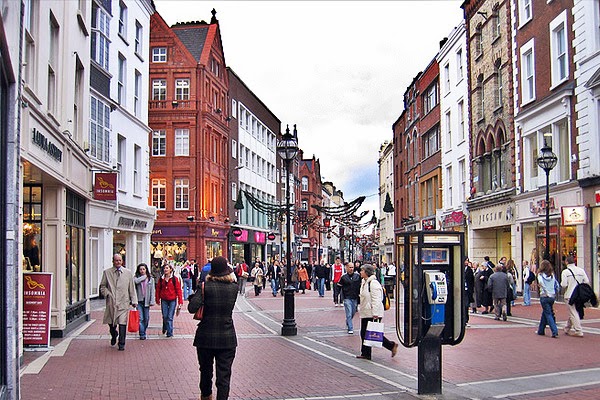Ireland
is an island in the Atlantic off the north-western coast
of continental Europe. It is the third-largest
island in Europe and the twentieth-largest island on
Earth. To its east is the island of Great Britain, from which it is
separated by the Irish Sea and North Channel.
Ireland
is divided between the Republic of Ireland, which covers five-sixths
of the island, and Northern Ireland, a part of the United Kingdom, which
covers the remaining area and is located in the north-east of the island. The
population of Ireland is approximately 6.4 million. Just under
4.6 million live in the Republic of Ireland and just over 1.8 million
live in Northern Ireland.
Flying through Ireland
CULTURE
Irish
culture has had a significant influence on other cultures, especially in
the fields of literature and, to a lesser degree, science and
education. Alongside mainstream Western culture, a strong indigenous
culture exists, as expressed for example through Gaelic games, Irish
music, and the Irish language. The culture of the island has also many
features shared with Great Britain, including the English language, and sports
such as association football, rugby, horse
racing and golf.
 |
| Irish Music is well known all over the world |
HISTORY
The
Celts arrived in Ireland sometime around 300 BC and ruled the country for the
next 1000 years, leaving footprints in the art and culture that can still be
found today. Christianity came to Ireland from the third century and V. The
Vikings ruled from the eighteenth century onwards until the country became part
of the British kingdom in 1169. A long struggle for independence took place
until 1922, after the Irish War of Independence, when the 26 southern counties
of Ireland gained independence from the United Kingdom and became the Irish
Free State, and after 1948, in the Republic Ireland.
History of Ireland in 6 minutes
ECONOMY
Despite
the two jurisdictions using two distinct currencies
(the euro and pound sterling), a growing amount of commercial
activity is carried out on an all-island basis. This has been facilitated by
the two jurisdictions' shared membership of the European Union, and there
have been calls from members of the business community and policymakers for the
creation of an "all-island economy" to take advantage
of economies of scale and boost competitiveness.
 |
| Some companies based in Ireland |
GEOGRAPHY
The
island of Ireland is located in the north-west of Europe. It is separated
from the neighbouring island of Great Britain by the Irish Sea and
the North Channel. To the west is the northern Atlantic
Ocean and to the south is the Celtic Sea, which lies between Ireland
and Brittany, in France. Ireland has a total area of
84,421 km2. Ireland and Great Britain, together with nearby islands,
are known collectively as the British Isles. As the term British
Isles is controversial in relation to Ireland, the alternate
term Britain and Ireland is often used as a neutral term for the
islands.
 |
| Kinvara Castle. County Clare. Ireland |
 |
| Cliffs of Moher. County Clare. Ireland |
Inland
areas are warmer in summer and colder in winter. Usually around 40 days of the
year are below freezing 0 °C(32 °F) at inland weather stations,
compared to 10 days at coastal stations. Ireland is sometimes affected by heat
waves, most recently in 2006 and 2013. In common with the rest of Europe,
Ireland experienced unusually cold weather during the winter of 2009/10.
Temperatures fell as low as −17.2 °C (1 °F) in County Mayo on 20 December and
up to a metre of snow in mountainous areas.
MAIN CITIES
Belfast City
Small
but with a big heart, super-cool Belfast is one of Europe’s true renaissance
cities. And from playing host to the MTV Europe Awards to being a centre of all
things Titanic, the capital of Northern Ireland has got its groove on in a big
way
Dublin City
Since
the end of World War II until 1973 Dublin experienced no major changes. It is
from this date that Ireland is integrated in the European Union and an
unstoppable way off. Recent years have come full turn the landscape of Dublin,
corporations have been installed in the capital and new buildings have changed
the picture of the city. Today is a very
touristy town visited by thousands of Europeans by the spirit of freedom and
youth you breathe.
 |
| Dublin City |
Galway
Galway
City at the mouth of Galway Bay is both a picturesque and lively city with a
wonderful avant-garde culture and a fascinating mixture of locally owned
speciality shops, often featuring locally made crafts. With a youthful
population and a bohemian spirit, Galway’s charms are best enjoyed by strolling
the city lanes and soaking up the atmosphere. There’s plenty to keep sightseers
happy, too.
 |
| Galway |
Cork
Cork
is an historic, creative, exciting, ever-changing city with extraordinary
surprises to be discovered every time you turn a corner. You just have to be
curious enough to venture off the beaten path.
The possibilities are endless, so forget what you think you know. Take a
chance, roll the dice and see where it leads you.
Kilkenny
Kilkenny's rich
medieval heritage is evident in the city's treasure trove of historical
buildings and landmarks, exemplified by the magnificent Kilkenny Castle.
Kilkenny is arguably the pre-eminent medieval city in Ireland, with the current
layout of the city clearly grounded in the city's medieval roots. |
| Kilkenny |



No comments:
Post a Comment